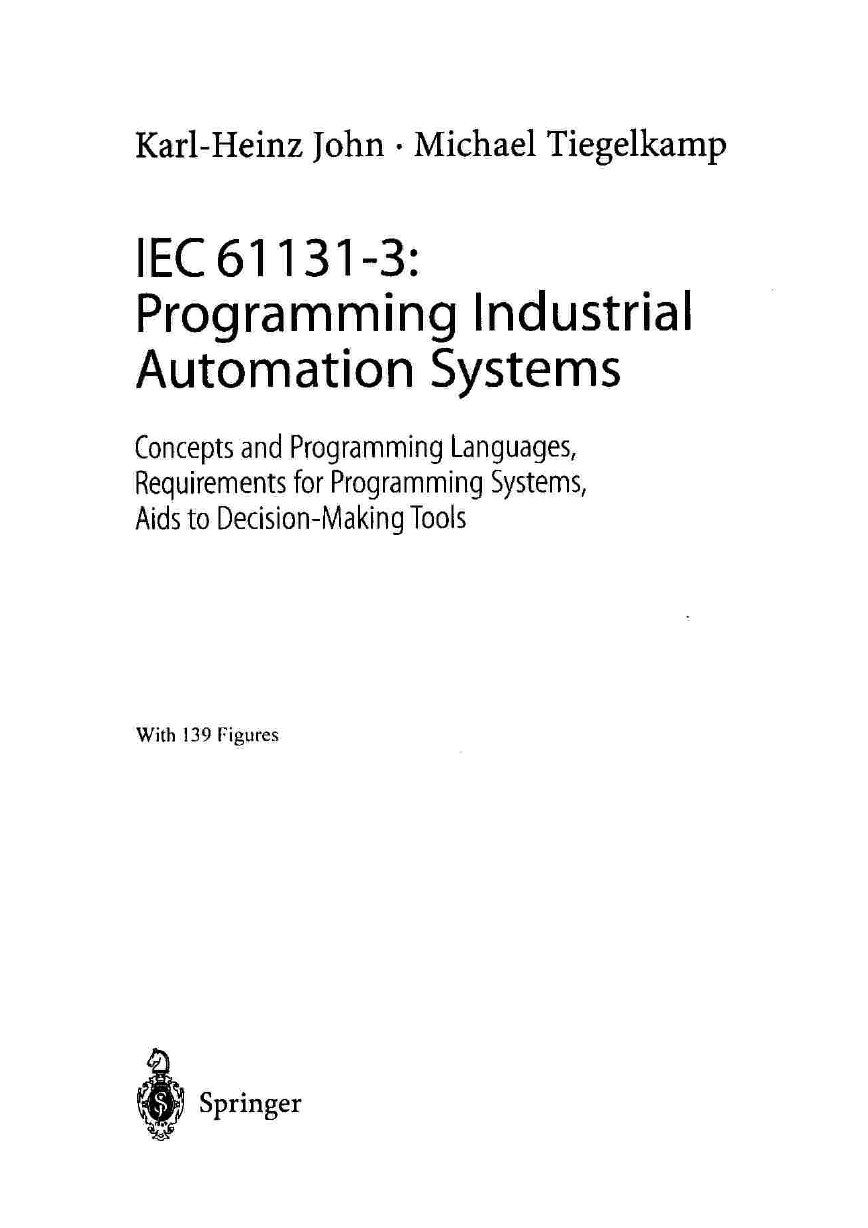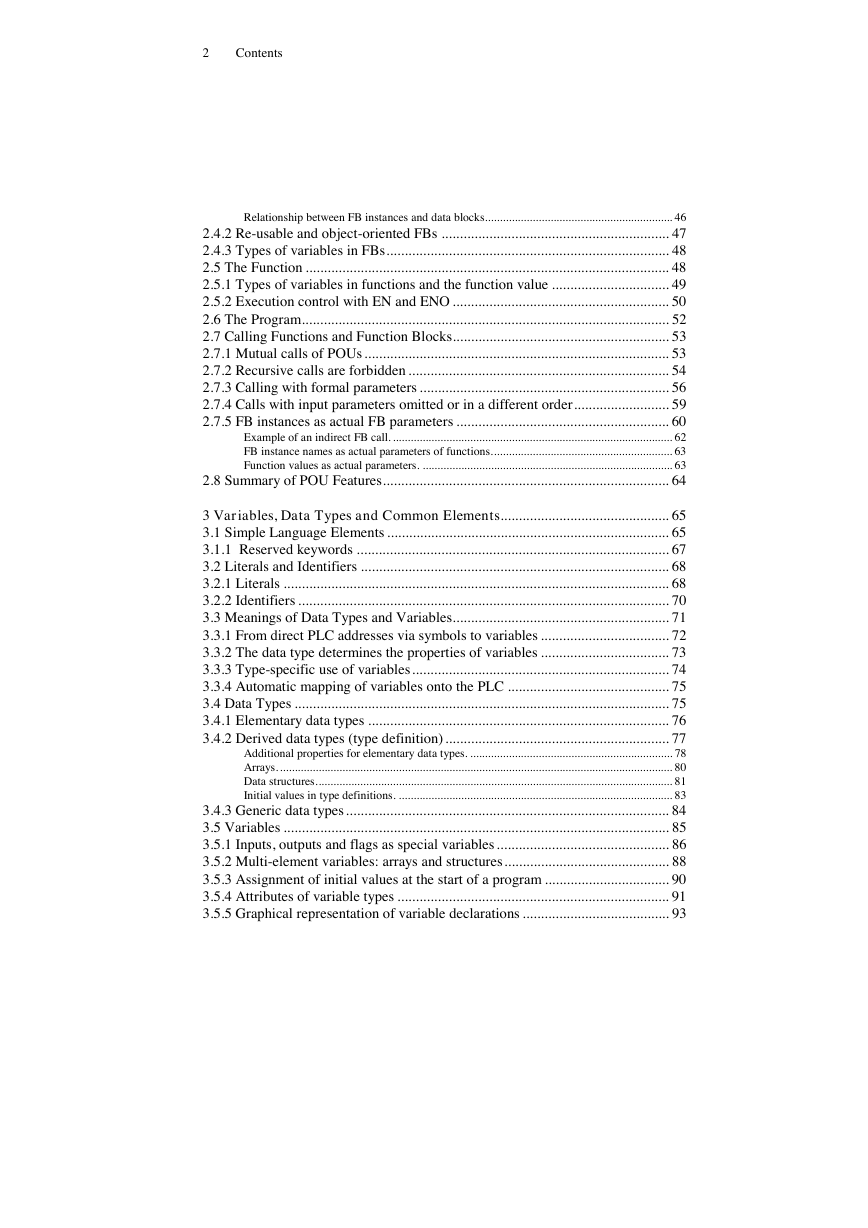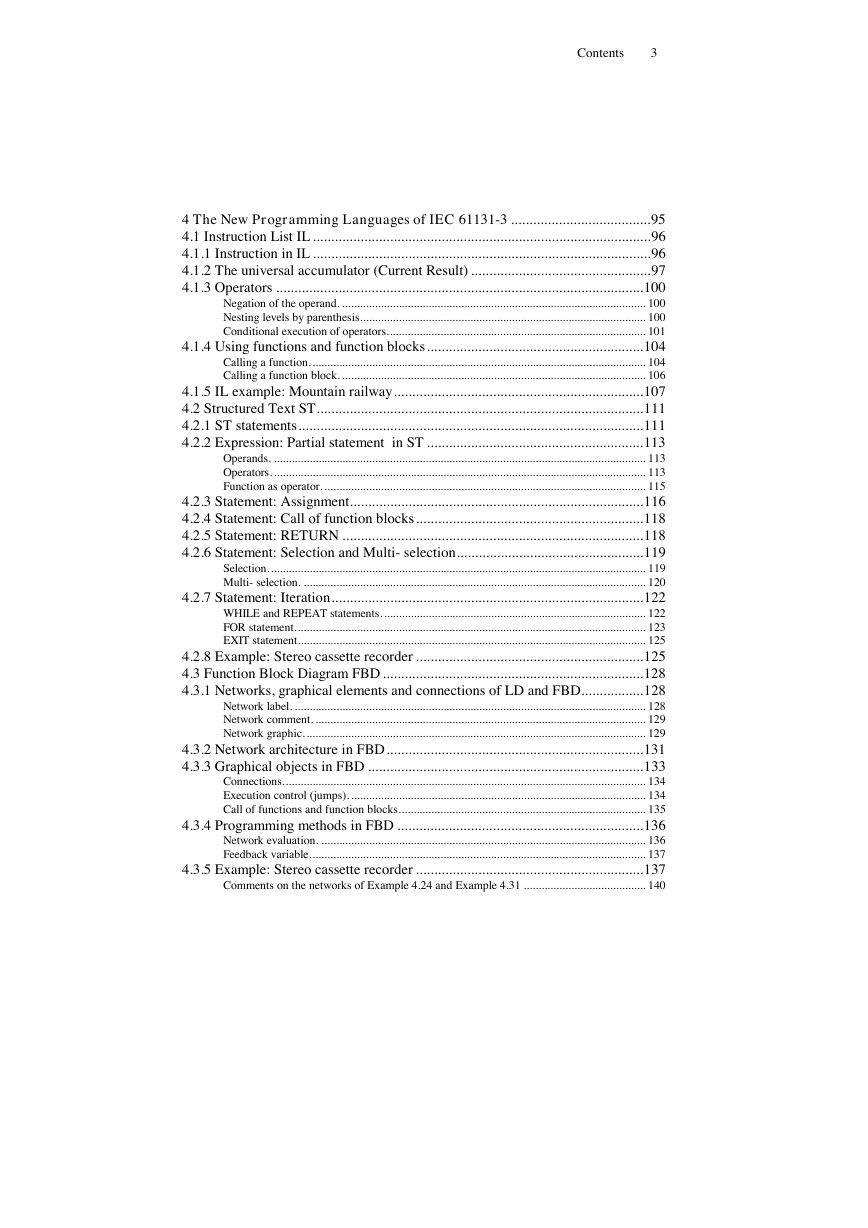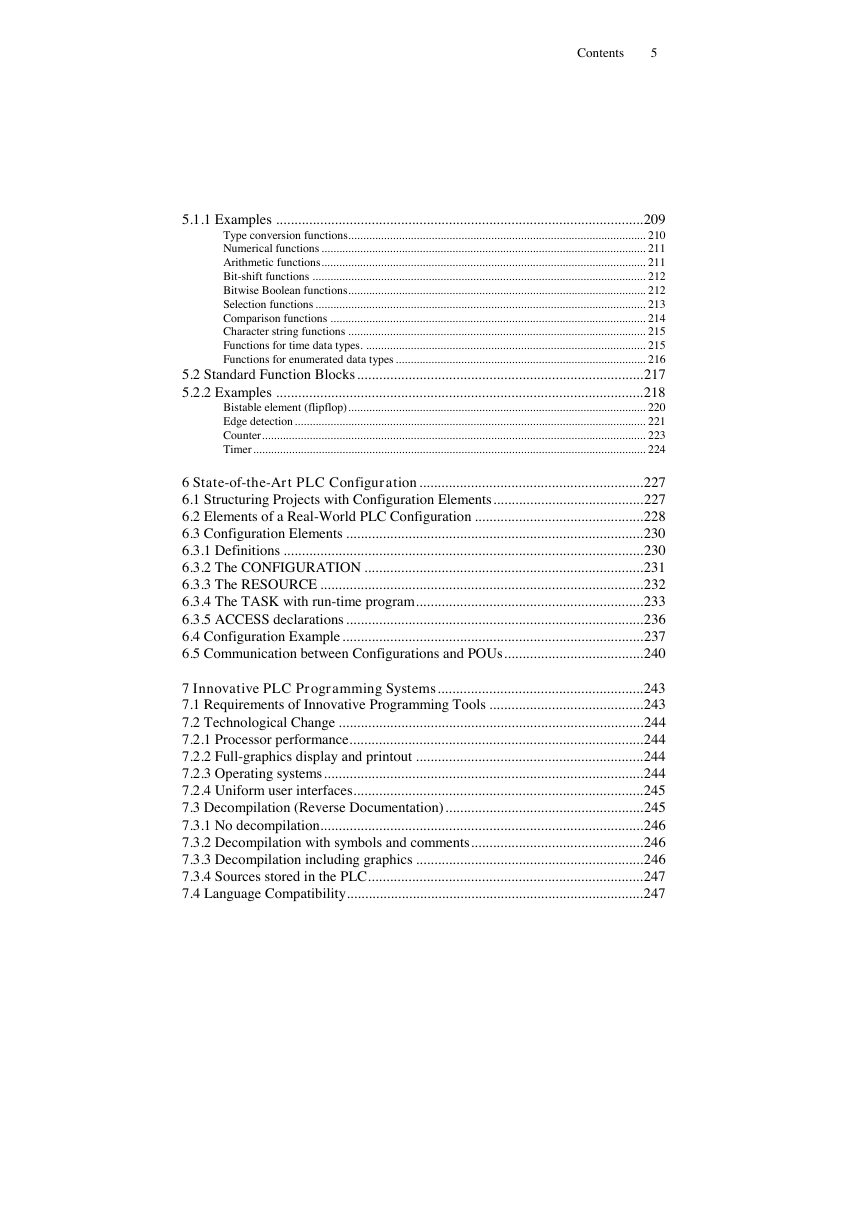Strukturierte Lesezeichen
Contents
1 Introduction
1.1 Subject of the Book
1.2 The IEC 61131 standard
1.2.1 Goals and benefits of the standard
Manufacturers (PLC hardware and software)
Customers
1.2.2 History and components
1.3 The Organisation PLCopen
1.3.1 Aims
1.3.2 Committees and fields of activity
1.3.3 Results
Certification
Exchange format for user programs
2 Building Blocks of IEC€61131
2.1 Introduction to the New Standard
2.1.1 Structure of the building blocks
Declaration of variables
Code part of a POU
2.1.2 Introductory example written in IL
2.1.3 PLC assignment
2.2 The Program Organisation Unit (POU)
2.3 Elements of a POU
2.3.1 Example
2.3.2 Declaration part
Types of variables in POUs.
Characteristics of the POU interface
The formal parameters and return values of a POU
External and internal access to POU variables
2.3.3 Code part
2.4 The Function Block
2.4.1 Instances of function blocks
What is an “instance”?
Instance means “structure”.
Instance means “memory”.
Relationship between FB instances and data blocks.
2.4.2 Re-usable and object-oriented FBs
2.4.3 Types of variables in FBs
2.5 The Function
2.5.1 Types of variables in functions and the function value
2.5.2 Execution control with EN and ENO
2.6 The Program
2.7 Calling Functions and Function Blocks
2.7.1 Mutual calls of POUs
2.7.2 Recursive calls are forbidden
2.7.3 Calling with formal parameters
2.7.4 Calls with input parameters omitted or in a different order
2.7.5 FB instances as actual FB parameters
Example of an indirect FB call.
FB instance names as actual parameters of functions.
Function values as actual parameters.
2.8 Summary of POU Features
3 Variables, Data Types and Common Elements
4 The New Programming Languages of IEC€61131-3
5 Standardised PLC Functionality
5.1 Standard Functions
5.1.1 Overloaded and extensible functions
Overloaded functions
Extensible functions
5.1.1 Examples
Type conversion functions
Numerical functions
Arithmetic functions
Bit-shift functions
Bitwise Boolean functions
Selection functions
Comparison functions
Character string functions
Functions for time data types.
Functions for enumerated data types
5.2 Standard Function Blocks
5.2.2 Examples
Bistable element (flipflop)
Edge detection
Counter
Timer
6 State-of-the-Art PLC Configuration
6.1 Structuring Projects with Configuration Elements
6.2 Elements of a Real-World PLC Configuration
6.3 Configuration Elements
6.3.1 Definitions
6.3.2 The CONFIGURATION
6.3.3 The RESOURCE
6.3.4 The TASK with run-time program
6.3.5 ACCESS declarations
6.4 Configuration Example
6.5 Communication between Configurations and POUs
7 Innovative PLC Programming Systems
7.1 Requirements of Innovative Programming Tools
7.2 Technological Change
7.2.1 Processor performance
7.2.2 Full-graphics display and printout
7.2.3 Operating systems
7.2.4 Uniform user interfaces
7.3 Decompilation (Reverse Documentation)
7.3.1 No decompilation
7.3.2 Decompilation with symbols and comments
7.3.3 Decompilation including graphics
7.3.4 Sources stored in the PLC
7.4 Language Compatibility
7.4.1 Cross-compilation
The motivation for cross-compilation
Different approaches in graphical and textual languages.
Differences in languages affect cross-compilation.
Restrictions in LD/ FBD.
Restrictions in IL/ ST.
Cross-compilation IL / ST.
Full cross-compilation only with additional information.
Quality criteria for cross-compilation.
7.4.2 Language independence
7.5 Documentation
7.5.1 Cross-reference list
7.5.2 Allocation list (wiring list)
7.5.3 Comments
7.6 Project Manager
7.7 Test & Commissioning Functions
7.7.1 Program transfer
7.7.2 Online modification of a program
7.7.3 Remote control: Starting and stopping the PLC
7.7.4 Variable and program status
7.7.5 Forcing
7.7.6 Program test
7.7.7 Testing Sequential Function Chart programs
7.8 Data Blocks and Recipes
7.9 FB Interconnection
7.9.1 Data exchange and co-ordination of blocks in distributed systems
7.9.2 Macro techniques in FB interconnection
7.10 Diagnostics, Error Detection and Error Handling
Error concept of IEC€61131
Extended error handling model (beyond IEC).
7.11 Hardware-Dependence
7.12 Readiness for New Functionality
7.12.1 Exchange of programs and data
7.12.2 Extension with additional software packages
8 Main Advantages of IEC€61131
8.1 Convenience and Security with Variables and Data Types
8.2 Blocks with Extended Capabilities
8.3 PLC Configuration with Run-Time Behaviour
8.4 Uniform Programming Languages
8.5 Structured PLC Programs
8.6 Trend towards Open PLC Programming Systems
8.7 Conclusion
9 Programming by Configuring with IEC€61499
9.1 Programming by FB Interconnection with IEC€61131
9.2 IEC 61499 – The Programming Standard for Distributed PLC Systems
9.2.1 System model
9.2.2 Device model
9.2.3 Resource model
9.2.4 Application model
9.2.5 Function block model
Composite function blocks
9.2.6 Creating an application
9.3 Overview of the Parts of IEC€61499
10 Contents of CD-ROM
10.1 IEC Programming Systems STEP€7 and OpenPCS
Demo versions of STEP€7 (Siemens) and OpenPCS (infoteam).
Footnote
IL examples
10.2 Buyer's Guide for IEC€61131
A Standard Functions
A.1 Type Conversion Functions
A.2 Numerical Functions
A.3 Arithmetic Functions
A.4 Bit-Shift Functions
A.5 Bitwise Boolean Functions
A.6 Selection Functions for Max., Min. and Limit
A.7 Selection Functions for Binary Selection and Multiplexers
A.8 Comparison Functions
A.9 Character String Functions
A.10 Functions for Time Data Types
A.11 Functions for Enumerated Data Types
B Standard Function Blocks
B.1 Bistable Elements (Flip-Flops)
B.2 Edge Detection
B.3 Counters
B.4 Timers
C IL Examples
C.1 Example of a FUNCTION
C.2 Example of a FUNCTION_BLOCK
C.3 Example of a PROGRAM
D Standard Data Types
E Causes of Error
F Implementation-Dependent Parameters
G IL Syntax Example
G.1 Syntax Diagrams for IL
G.2 IL Example from Syntax Diagrams
H Reserved Keywords and Delimiters
H.1 Reserved Keywords
H.2 Delimiters
I Planned Amendments to the Standard
J Glossary
K Bibliography
L Index
















 2023年江西萍乡中考道德与法治真题及答案.doc
2023年江西萍乡中考道德与法治真题及答案.doc 2012年重庆南川中考生物真题及答案.doc
2012年重庆南川中考生物真题及答案.doc 2013年江西师范大学地理学综合及文艺理论基础考研真题.doc
2013年江西师范大学地理学综合及文艺理论基础考研真题.doc 2020年四川甘孜小升初语文真题及答案I卷.doc
2020年四川甘孜小升初语文真题及答案I卷.doc 2020年注册岩土工程师专业基础考试真题及答案.doc
2020年注册岩土工程师专业基础考试真题及答案.doc 2023-2024学年福建省厦门市九年级上学期数学月考试题及答案.doc
2023-2024学年福建省厦门市九年级上学期数学月考试题及答案.doc 2021-2022学年辽宁省沈阳市大东区九年级上学期语文期末试题及答案.doc
2021-2022学年辽宁省沈阳市大东区九年级上学期语文期末试题及答案.doc 2022-2023学年北京东城区初三第一学期物理期末试卷及答案.doc
2022-2023学年北京东城区初三第一学期物理期末试卷及答案.doc 2018上半年江西教师资格初中地理学科知识与教学能力真题及答案.doc
2018上半年江西教师资格初中地理学科知识与教学能力真题及答案.doc 2012年河北国家公务员申论考试真题及答案-省级.doc
2012年河北国家公务员申论考试真题及答案-省级.doc 2020-2021学年江苏省扬州市江都区邵樊片九年级上学期数学第一次质量检测试题及答案.doc
2020-2021学年江苏省扬州市江都区邵樊片九年级上学期数学第一次质量检测试题及答案.doc 2022下半年黑龙江教师资格证中学综合素质真题及答案.doc
2022下半年黑龙江教师资格证中学综合素质真题及答案.doc